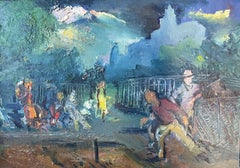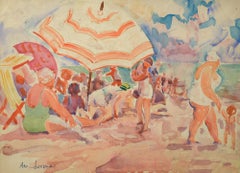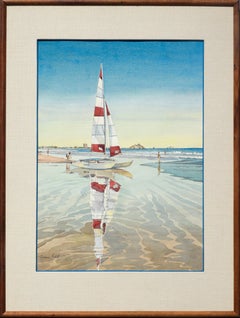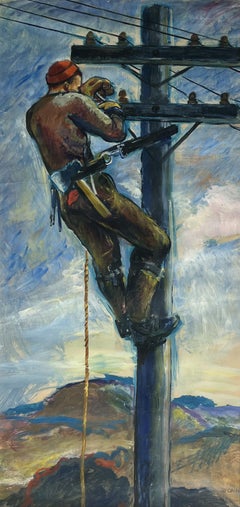Aaron Berkman Art
American, 1900-1991
Aaron Berkman was born in Hartford, Connecticut in 1900. In 1916 Berkman attended the Connecticut League of Art Students, founded by Charles Noel Flagg. Beginning in 1919 he studied under Albertus E. Jones at the Hartford Art School. Berkman was influenced during this time by George Inness and John Singer Sargent and the Old Masters. He received a scholarship to the Museum Art School of Boston in 1921 and then traveled to Europe, remaining there from 1924 through 1925. He spent time in France, Italy, Spain, Holland and Belgium. In 1929 Berkman moved to New York City, continuing a friendship and painting relationship with Milton Avery. He was appointed by the W.P.A. as Director of the WPA Art Center at the 92nd Street Y in New York City. Berkman helped established the A.C.A. Gallery in New York City at 52 West 8th St., the first Artist Cooperative Gallery in New York City. He spent summers on Monhegan Island in Maine, Cape Ann in Massachusetts, the Connecticut Shore, Vermont and the Adirondacks. When the WPA ended, the 92nd Street Y became the Y Art Center, with Berkman remaining as the Director. He also taught art classes and lectured on art history. Berkman had many one-man exhibitions and group shows. He wrote two books. Art and Space and The Functional Line and was a columnist for ARTnews. When Berkman retired from the position at the Y Art Center, he established Bercone Gallery, New York City where he continued to paint, teach and exhibit. His work appears in many corporate, private and museum collections.(Biography provided by Wiscasset Bay Gallery)
to
4
2
1
3
1
2
1
1
Overall Height
to
Overall Width
to
3
4
3
2
2
1
1
1
1
4
1
4
6,938
3,292
2,514
1,213
4
3
3
3
1
Artist: Aaron Berkman
Abstract painting of People on the Beach oil on canvas circa 1950-1960 New York
By Aaron Berkman
Located in Rancho Santa Fe, CA
Aaron Berkman (New York, 1900 - 1929)
"Beach"
Oil on canvas
20 x 24 inches
Signed lower right: Aaron Berkman
Unframed
Provenance: Private collection, USA
An abstract oil painting o...
Category
Mid-20th Century American Modern Aaron Berkman Art
Materials
Canvas, Oil
People Lawn Bowling in Central Park New York City 1950 oil/canvas NYC blue green
By Aaron Berkman
Located in Rancho Santa Fe, CA
Aaron Berkman (1900 - 1991)
“Bowling in Central Park” New York
Oil on canvas
10 x 14 inches
Signed and titled verso: Aaron Berkman 1950
Provenance:
Private collection, USA
Aaron Ber...
Category
1950s American Modern Aaron Berkman Art
Materials
Canvas, Oil
The Party - oil on canvas - New York City town house at night - 20th century
By Aaron Berkman
Located in Rancho Santa Fe, CA
Oil on canvas
30 x 24 inches
Signed verso
Not framed
Provenance:
Private collection, USA
Aaron Berkman was born in Hartford, Connecticut where his parents had been settled since 1...
Category
Mid-20th Century American Modern Aaron Berkman Art
Materials
Oil, Canvas
"Under the Beach Umbrella, " American Realist, Watercolor, Seaside, Figural
By Aaron Berkman
Located in Wiscasset, ME
Aaron Berkman was born in Hartford, Connecticut in 1900. In 1916 Berkman attended the Connecticut League of Art Students, founded by Charles Noel Flagg. Beginning in 1919 he studied under Albertus E. Jones at the Hartford Art School. Berkman was influenced during this time by George Inness and John Singer Sargent and the Old Masters. He received a scholarship to the Museum Art School of Boston in 1921 and then traveled to Europe, remaining there from 1924 through 1925. He spent time in France, Italy, Spain, Holland and Belgium. In 1929 Berkman moved to New York City, continuing a friendship and painting relationship with Milton Avery. He was appointed by the W.P.A. as Director of the WPA Art Center at the 92nd Street Y in New York City. Berkman helped established the A.C.A. Gallery in New York City at 52 West 8th St., the first Artist Cooperative Gallery in New York City. He spent summers on Monhegan Island in...
Category
20th Century American Realist Aaron Berkman Art
Materials
Watercolor
Related Items
Mid Century Mazatlan Beach Catamaran Figurative Landscape Watercolor
By William A. Corbett
Located in Soquel, CA
Vibrant figurative seascape of a beach in Mazatlan, Mexico with several figures and a catamaran reflecting beautifully in the shallow water by William A. Corbett (American. 1914-1960). Titled "Beach- Mazatlan" on verso. Signed "William Corbett" in lower left corner. Presented in a simple wood frame, with a double mat of off-white silk and royal blue with plexiglass. Image size: 22”H x 14.75”L
William A. Corbett began drawing at an early age. He constructed signs and displays for theaters and nightclubs around Pittsburg. He studied art with Vincent Nesbert at the Pittsburg Art Institute and with Robert Gwathmoy, Roy Hilton, and Robert Laper at the Carnegie Institute of Technology. He also studied painting and sculpture at the Louisville Art Center. Corbett was in the Army Engineers at Fort Knox, Kentucky where he studied, practiced, and had exhibits with army artists there from 1941-1943. He was very much interested in materials and technique, content and style in painting. His favorite Artists were El Greco, Leonardo, Rembrandt, Renoir, Burchfield, and Andrew Wyeth, Jr. He studied two years at Boston museum School with Karl Zerbe, Daivid Aronson and others. He later designed and did art work for General Outdoor Advertising Co. In 1943, he married Ruth Osborne of Louisville and they had one son, Michael. In 1951 he moved to Fort Lauderdale, Florida with his family.
Exhibitions:
Army Art Show--- 1st Prize in Landscape, 1942
Kentucky & southern Indiana Exhibition-- Honorable
mentions for Fisherman's Curse 1949, Don Q...
Category
1960s American Realist Aaron Berkman Art
Materials
Watercolor, Paper
H 27.25 in W 20.25 in D 0.75 in
Man Working Mid 20th Century American Scene Social Realism Industrial WPA Modern
By Jo Cain
Located in New York, NY
Man Working Mid 20th Century American Scene Social Realism Industrial WPA Modern
Jo Cain (1904 - 2003)
Telephone Pole Worker
38 1/4 x 18 1/2 inches
Oil on pap...
Category
1930s American Realist Aaron Berkman Art
Materials
Paper, Gouache
Six O'Clock
Located in Los Angeles, CA
Six O-Clock, c. 1942, oil on canvas, 30 x 20 inches, signed and titled several times verso of frame and stretcher (perhaps by another hand), marked “Rehn” several times on frame (for the Frank K. M. Rehn Galleries in New York City, who represented Craig at the time); Exhibited: 1) 18th Biennial Exhibition of Contemporary American Oil Paintings from March 21 to May 2, 1943 at The Corcoran Gallery of Art in Washington, D.C. #87, original price $450 (per catalog) (exhibition label verso), 2) Craig’s one-man show at the Frank K. M. Rehn Galleries, New York City, from October 26 to November 14, 1942, #10 (original price listed as $350); and 3) Exhibition of thirty paintings sponsored by the Harrisburg Art Association at the State Museum of Pennsylvania in Harrisburg in March, 1944 (concerning this exhibit, Penelope Redd of The Evening News (Harrisburg, Pennsylvania) wrote: “Other paintings that have overtones of superrealism inherent in the subjects include Tom Craig’s California nocturne, ‘Six O’Clock,’ two figures moving through the twilight . . . .” March 6, 1944, p. 13); another label verso from The Museum of Art of Toledo (Ohio): original frame: Provenance includes George Stern Gallery, Los Angeles, CA
About the Painting
Long before Chris Burden’s iconic installation outside of the Los Angeles County Museum of Art, Urban Light, another artist, Tom Craig, made Southern California streetlights the subject of one of his early 1940s paintings. Consisting of dozens of recycled streetlights from the 1920s and 1930s forming a classical colonnade at the museum’s entrance, Burden’s Urban Light has become a symbol of Los Angeles. For Burden, the streetlights represent what constitutes an advanced society, something “safe after dark and beautiful to behold.” It seems that Craig is playing on the same theme in Six O-Clock. Although we see two hunched figures trudging along the sidewalk at the end of a long day, the real stars of this painting are the streetlights which brighten the twilight and silhouette another iconic symbol of Los Angeles, the palm trees in the distance. Mountains in the background and the distant view of a suburban neighborhood join the streetlights and palm trees as classic subject matter for a California Scene painting, but Craig gives us a twist by depicting the scene not as a sun-drenched natural expanse. Rather, Craig uses thin layers of oil paint, mimicking the watercolor technique for which he is most famous, to show us the twinkling beauty of manmade light and the safety it affords. Although Southern California is a land of natural wonders, the interventions of humanity are already everywhere in Los Angeles and as one critic noted, the resulting painting has an air of “superrealism.”
About the Artist
Thomas Theodore Craig was a well-known fixture in the Southern California art scene. He was born in Upland California. Craig graduated with a degree in botany from Pomona College and studied painting at Pamona and the Chouinard Art School with Stanton MacDonald-Wright and Barse Miller among others. He became close friends with fellow artist Milford Zornes...
Category
1940s American Modern Aaron Berkman Art
Materials
Canvas, Oil
Mid Century Sitting Nude Figurative
By Elmer Albritton
Located in Soquel, CA
Mid Century figurative painting of a pensive sitting nude figure with moody, mid-century color palette in the background. Attributed to Elmer S. Albritton, unsigned (American, 1922-...
Category
1960s American Modern Aaron Berkman Art
Materials
Canvas, Oil, Cardboard
Gold Mine, Central City, Colorado
By Joseph Meert
Located in Los Angeles, CA
This painting is part of our exhibition America Coast to Coast: Artists of the 1930s
Goldmine, Central City, Colorado, oil on canvas, 36 x 28 inches, c. 1936, signed lower right, ex collection of Platt Fine Art, Chicago, Illinois (label verso).
About the Painting
Joseph Meert’s painting, Goldmine, Central City, Colorado, depicts the short-lived resurrection of a once prominent city just outside Denver. Central City was founded in 1859 soon after John Gregory struck gold in the area. As word spread, thousands of miners converged into “Gregory’s Gulch” and its surroundings became known as the “richest square mile on earth.” Mining production quickly increased resulting in Central City to becoming Colorado’s largest city in the early 1860s. Despite some technical difficulties transitioning to lode mining and the rise of competition from Leadville, Central City remained an economic boom town through the turn of the century. But, with every boom, there is a bust. World War I marked the end of Central City’s prominence as ore production ground to a halt and by 1925, the town’s population shrank to only 400 people. The desperation of the Great Depression and a nearly 100% increase in the price of gold lured labor and capital back to Central City. Meert painted in Colorado during the mid-1930s, a time when he created his most desirable works. It is during this period of renaissance that Meert captures one of Central City's outlying dirt streets bordered by 19th century wooden houses from the town's heyday and the more recently installed electric lines leading to a distant gold mine. A lone figure trudges up the hill, a mother with a baby in her arms, putting us in mind of the rebirth of the town itself. Meert had solo exhibitions at the Colorado Springs Fine Arts Center in 1936 and the Denver Art Museum. Although it is not known whether Goldmine, Central City was included in either of these exhibitions, it seems likely. Moreover, the painting is closely related to Meert’s painting, The Old Road, which was painted in 1936 and exhibited at the Corcoran Gallery of Art in Washington, DC and at the Dallas Museum of Art.
About the Artist
Joseph Meert was a well-regarded painter and muralist, who initially made a name for himself in the American Scene and later as an abstract expressionist. Although initially successful, Meert struggled financially and with mental illness later in life. He was born in Brussels, Belgium, but moved with his family to Kansas City, Missouri. As a child, a chance encounter at the Union Pacific Railyard changed his life. Meert happened upon a worker repainting and stenciling a design on a railroad car. Meert later recalled that this experience introduced him to the idea of being a painter. Without support from his father, Meert obtained a working scholarship to the Kansas City Art Institute. After four years at the Kansas City Art Institute, Meert studied seven years at the Art Students League and in Europe and Los Angeles. At the Art Students League, Meert fell under the spell of Thomas Hart Benton and Stanton MacDonald-Wright. In 1931, he befriended Jackson Pollock. By 1934, Meert was part of the Public Works of Art Project when he met his wife, Margaret Mullin...
Category
1930s American Modern Aaron Berkman Art
Materials
Oil, Canvas
"Going to the Festival" WPA Ashcan 20th Century American Scene Modern Realism
By Daniel Ralph Celentano
Located in New York, NY
"Going to the Festival" WPA Ashcan 20th Century American Scene Modern Realism
Daniel Celentano (1902 - 1980) "Going to the Festival," 14 1/2 x 10 1/2. Watercolor on paper, c. 1930s....
Category
1930s American Realist Aaron Berkman Art
Materials
Paper, Watercolor
Oil Painting by Well Known Cartoonist and Illustrator Upper East Side, Manhattan
By Sandy Huffaker
Located in Surfside, FL
An Upper East Side of Manhattan New York city scene of bald guy reading newspaper on bench with East River and tugboat in background.
The 1970s were the “glory days,” Huffaker says, for himself and a stable of talented illustrators whose work routinely found itself on the covers of the nation’s premier newsmagazines and in the pages of The New York Times. For the better part of that decade, Huffaker was among an elite breed of commercial artists—his hero and fellow Southerner Jack Davis, the legendary Mad Magazine illustrator, among them—working during a remarkable period when art directors routinely turned to illustration to give comic relief to the country’s deeply serious and dark problems. From civil rights and the women’s movement to Vietnam and Watergate, the gas crisis and inflation to the rise of Jimmy Carter, Huffaker mined a deep well of material ripe for his brand of visual wit and caustic satire. He sent his portfolio to children's book illustrator Maurice Sendak, the legendary “Where The Wild Things Are” illustrator to gauge his prospects, and when Sendak replied, “C’mon up, you’ll do all right,”
SELECT HONORS:
2 Page-One Awards (from the New York Newspaper Guild), for work in Fortune Magazine and Sports Illustrated.
Nominated 3 times for Cartoonist-of-the-Year by the National Cartoonists Society (illustration category).
Desi Award of Excellence (Graphic Design Magazine).
20 Award of Merit citations from the Society of Illustrators.
One-man show, Society of Illustrators.
Illustrators 22 - annual national exhibition for the Society of Illustrators.
SELECT MAGAZINE COVERS
Time Magazine (6),
Sports Illustrated (2),
Business Week (12),
Forbes,
Saturday Review,
New York Times Sunday Magazine,
The New Republic,
Family Weekly,
Madison Avenue,
New York Daily News Sunday Magazine (2),
Junior Scholastic,
ACLU,
The Nation , and more
EDUCATION BA, University of Alabama. Attended Pratt Graphic Center and The Art Students League, New York City.
BOOKS WRITTEN AND ILLUSTRATED The Dispensible Man (M. Evans and Co.) and The Bald Book (M. Evans and Co.) BOOKS ILLUSTRATED White Is (Grove Press), The Begatting of a President (Ballantine Books), The Biggest Sneeze (Harper-Collins), H. Phillip Birdsong's ESP (Young Scott Books), Kids Letters to President Reagan (M. Evans), The Worlds Greatest Left-Handers (M. Evans), Does My Room Come Alive at Night (HarperCollins), The Man With Big Ears (HarperCollins), Jake Snake's Race (HarperCollins), and more
POLITICAL CARTOONING Political cartoonist at The News and Obsever in Raleigh, NC and syndicated during the early 70's. Today, syndicated in 750 publications 3-times a week with Cagle Cartoons.
FINE ART SHOWS Allied Artists of America, Salmagundi Club, Phillips Mill Annual (honorable mention), New Hope Shad Festival (grand Prize), Hunter Museum in Chattanooga ( one -man career retrospective), Santa Fe public library (one--man), Rosenfeld Gallery (Philadelphia), Potter...
Category
20th Century American Modern Aaron Berkman Art
Materials
Canvas, Oil
Schooners along the Hudson, West Point Academy in the distance.
Located in Middletown, NY
A serene Hudson River scene by a student of Louis Comfort Tiffany.
Anna May Walling was born in 1881, a native of Goshen, New York. She was a graduate of the Blair Academy, and Prat...
Category
Early 20th Century American Realist Aaron Berkman Art
Materials
Watercolor, Handmade Paper
Bridge Painter WPA American Modernism Mid 20th-Century Realism Industrial Worker
By Louis Wolchonok
Located in New York, NY
Bridge Painter WPA American Modernism Mid 20th-Century Realism Industrial Worker. Sight size: 18 x 23 1/4 inches. Estate stamped verso.
This drawing is the study for a large oil we ...
Category
1930s American Realist Aaron Berkman Art
Materials
Watercolor, Paper
Rare Modernist Oil Painting Line Drawing Nude Man Louis Stettner
By Louis Stettner
Located in Surfside, FL
Signed and Dated Modern Line Drawing Oil Painting of Nude Man.
Louis Stettner (November 7, 1922 – October 13, 2016) was an American photographer of the 20th century whose work inclu...
Category
21st Century and Contemporary American Modern Aaron Berkman Art
Materials
Canvas, Oil
Abstract Procession Jewish Wedding Chuppah Oil Painting Modernist Judaica
By Sabina Teichman
Located in Surfside, FL
Genre: Modern
Subject: Abstract
Medium: Oil
Surface: Canvas
Country: United States
Sabina Teichman: (1905-1983) Studied at Columbia Univ. (BA, MA), also with Charles J. Martin and A...
Category
1950s American Modern Aaron Berkman Art
Materials
Canvas, Oil
"Brick Layers" WPA American Scene Mid 20th Century Modern Drawing Men Working
By David Fredenthal
Located in New York, NY
"Brick Layers" WPA American Scene Mid 20th Century Modern Drawing Men Working.
21 x 15 inches Watercolor on paper. c. 1938. Signed lower left.
BIO
David Fredenthal (1914 - 1958) was one ot America's most respected watercolor artists. He was famous for his bold, intensely vigorous and complex paintings and drawings that expressed his deep feeling for excitement with life and living. He was a draftsman with seemingly a special gift for catching anything, physically and emotionally on the spot, and he never went anywhere without three or four loaded pens and a sketchbook in his pocket. As part of the WPA project he executed a number of murals including the Sports Pavilion on the Heinz Building of the New York World's Fair 1939. Some of his fresco and mural techniques were inspired by his friendship with Diego Rivera who had admired and encouraged him in the early 1930's. After he won a traveling scholarship to Europe from The Museum of Modern Art at age 19, he was the recipient of two Guggenheim grants in Painting. He had his first solo exhibition at the Downtown Gallery in New York in 1937 at age 23, and many others after that including the Whitney Museum of American Art in 1947. Because of Fredenthal's prodigious drawing gifts, he was chosen by Erskine Caldwell to illustrate his novel "Tobacco Road" in 1940. He was a War Artist Correspondent for both the State Department (the European and Asian fronts) and Life magazine from 1943 to 1946 and his work was featured in Life magazine regularly during the war and after until the end of his life. Also featured in Life in 1956 were drawings that Fredenthal had vividly recorded on his sketch pad, of the entire filming of the movie, The Pride and the Passion, starring Cary Grant, Sophia Loren, and Frank Sinatra, along the treacherous mountain passes of Spain. Though he was fiercely committed to an art that expressed deeply human social values and issues and was quite hostile to abstraction, he was friendly with a number of abstract artists such as David Smith, Ad Reinhardt, Philip Guston, Paul Feeley, and Herman Cherry.
Category
1930s American Realist Aaron Berkman Art
Materials
Watercolor, Handmade Paper
Aaron Berkman art for sale on 1stDibs.
Find a wide variety of authentic Aaron Berkman art available for sale on 1stDibs. You can also browse by medium to find art by Aaron Berkman in paint, oil paint, canvas and more. Much of the original work by this artist or collective was created during the 20th century and is mostly associated with the modern style. Not every interior allows for large Aaron Berkman art, so small editions measuring 14 inches across are available. Customers who are interested in this artist might also find the work of Merton Clivette, Cecil Crosley Bell, and Virginia Rogers. Aaron Berkman art prices can differ depending upon medium, time period and other attributes. On 1stDibs, the price for these items starts at $900 and tops out at $3,300, while the average work can sell for $2,000.



